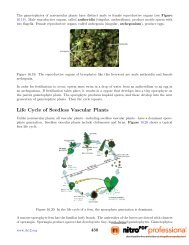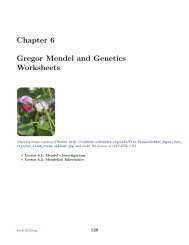Chapter 23 The Circulatory, Respiratory, Digestive, and Excretory ...
Chapter 23 The Circulatory, Respiratory, Digestive, and Excretory ...
Chapter 23 The Circulatory, Respiratory, Digestive, and Excretory ...
You also want an ePaper? Increase the reach of your titles
YUMPU automatically turns print PDFs into web optimized ePapers that Google loves.
How Breathing Occurs<br />
Inhaling is an active movement that results from the contraction of a muscle called the diaphragm. <strong>The</strong><br />
diaphragm is large, sheet-like muscle below the lungs (see Figure <strong>23</strong>.15). When the diaphragm contracts,<br />
the ribcage exp<strong>and</strong>s <strong>and</strong> the contents of the abdomen move downward. This results in a larger chest<br />
volume, which decreases air pressure inside the lungs. With lower air pressure inside than outside the<br />
lungs, air rushes into the lungs. When the diaphragm relaxes, the opposite events occur. <strong>The</strong> volume<br />
of the chest cavity decreases, air pressure inside the lungs increases, <strong>and</strong> air flows out of the lungs, like<br />
air rushing out of a balloon. You can watch an animation showing how breathing occurs at this link:<br />
http://www.youtube.com/watch?v=hp-gCvW8PRY&feature=related.<br />
Control of Breathing<br />
Figure <strong>23</strong>.15: Breathing depends on contractions of the diaphragm.<br />
<strong>The</strong> regular, rhythmic contractions of the diaphragm are controlled by the brain stem. It sends nerve<br />
impulses to the diaphragm through the autonomic nervous system. <strong>The</strong> brain stem monitors the level of<br />
carbon dioxide in the blood. If the level becomes too high, it “tells” the diaphragm to contract more often.<br />
Breathing speeds up, <strong>and</strong> the excess carbon dioxide is released into the air. <strong>The</strong> opposite events occur<br />
when the level of carbon dioxide in the blood becomes too low. In this way, breathing keeps blood pH<br />
within a narrow range.<br />
Diseases of the <strong>Respiratory</strong> System<br />
When you have a cold, your nasal passages may become so congested that it’s hard to breathe through<br />
your nose. Many other diseases also affect the respiratory system, most of them more serious than the<br />
common cold. <strong>The</strong> following list includes just a sample of respiratory system diseases.<br />
• Asthma is a disease in which the air passages of the lungs periodically become too narrow, often<br />
with excessive mucus production. This causes difficulty breathing, coughing, <strong>and</strong> chest tightness. An<br />
asthma attack may be triggered by allergens, strenuous exercise, stress, or other factors. You can<br />
learn more about asthma by watching the animation at this link: http://www.youtube.com/watch?<br />
v=S04dci7NTPk&feature=reated.<br />
www.ck12.org 702





